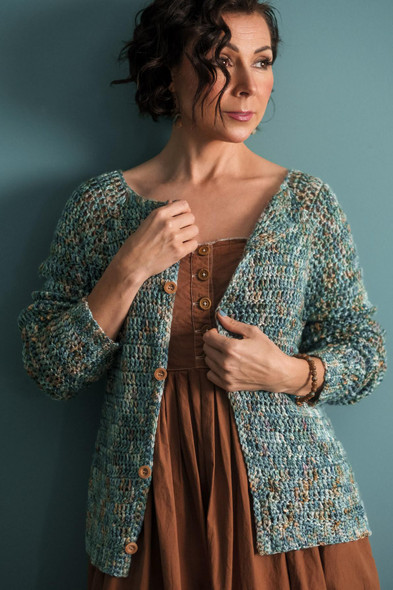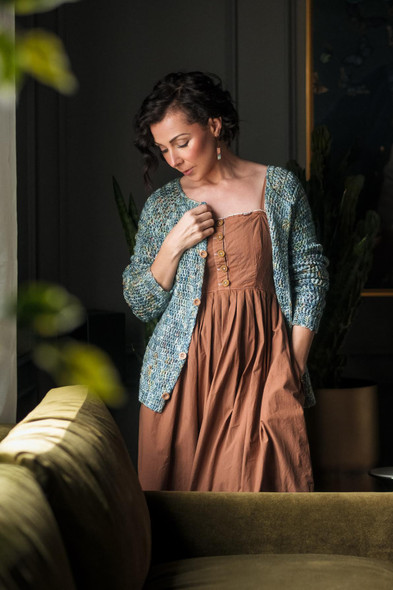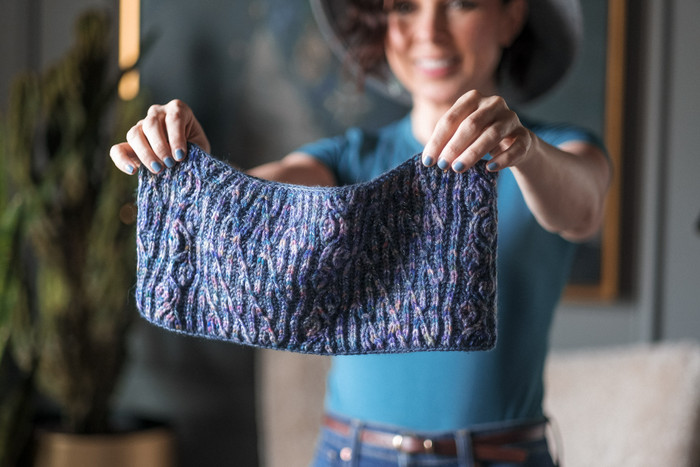SIZES:
Version 1: 30” (76 cm) circumference x 6.75” (17 cm) high
Version 2: 30” (76 cm) circumference x 13.5” (34.5 cm) high
MATERIALS:
Expression Fiber Arts Sparkle DK, Mirage Sport, Twisted Tweed Sport, or Luster Worsted yarn
Version 1: 1 skein of Sparkle DK, 1 skein of Mirage Sport
Shown in Twilight Lavender Sparkle DK and Timekeeper Mirage Sport
Version 2: 1 skein of Twisted Tweed Sport and 2 skeins of Luster Worsted
Shown in Conch Shell Twisted Tweed Sport and New York at Night Luster Worsted
If those colors aren't available, any from this category, this category, or this category will work.
NEEDLES:
Version 1: US #5 (3.75 mm) 24” circular needles
Version 2: US #6 (4.00 mm) 24” circular needles
SKILL LEVEL:
Advanced: For the adventurous knitter who loves to tackle something a bit more complicated. Knitters should be familiar with two-color basic brioche techniques and terminology.
Notes from the Designer:
Jeanne introduced you to the methods of brioche knitting. Working the patterns in a single color allowed you to focus on learning the technique. Josephine took it a step further and guided you through the basics of two-color brioche and a thorough understanding of the elements that are used to create this thick, cozy fabric. The third step in your brioche journey introduces increases and decreases. Learning these skills will open up a lot of new possibilities!
Marie uses two directions of decreases and one increase to create a pretty design that’s reminiscent of flowers and trellises. It is a smaller project with enough repetition to provide you with the opportunity to understand how these stitches work together to produce the designs. Any two similar weight yarns may be used to create your cowl.
- Making a gauge swatch is critical to achieve the desired results. Please DO NOT assume that you knit to the same gauge as I do! Yes, it is an extra step. However, it also assures you that what you are knitting will produce what you expect, and you won’t need to worry about running out of yarn. If you are substituting yarn, it is especially important to verify that it behaves in the same way as the yarn called for in the pattern.
- This pattern may be made with any two similar weight yarns. Adjust the number of cast on stitches (multiple of 24) to achieve the desired size. Work your first swatch in the needle size that is appropriate for the heavier weight yarn. Adjust if necessary, and swatch again.
- While learning how to work brioche, it is highly recommended that you use lifelines. If you need to rip back, it can be very confusing to find your stitches and yarn overs without one.
- Color 1 will be the Light Color (LC), and Color 2 will be referred to as the Dark Color (DC). The Light Color is the most prominent in the design on the right side.
- When working two-color brioche, one brioche row requires knitting the same row twice. You will work the row once in Color 1 (LC), and then work it again in Color 2 (DC).
- All single slipped stitches are worked with the needle inserted as if to purl. In the decreases, the brioche stitch is slipped knitwise.
- At the end of each round, always drop the LC to the back of the work and the DC to the front. This ensures that they are in the correct place when next used, without crossing over other stitches.
- When working the last stitch in every DC row, make sure the loose LC is still over the needle and worked into the brp1.
- Stitch Marker A is placed at the beginning of the round. Markers A and B are at the start of the trellis pattern, while Marker C begins the flower bud pattern.
- The stitch terminology that follows was developed by Nancy Marchant.
Designed by Jane Vanselous
You'll receive a digital file only (instantly downloadable as a PDF) and won't be shipped anything. Please allow a few minutes for the download link to be emailed to you. If the email doesn't arrive within a few minutes, just log into your account on our site, and you'll see your Completed Orders. From there, you'll find the download link.
Happy knitting!
Chandi
New? Read about our pattern download process here.
"Nothing in life is to be feared, it is only to be understood. Now is the time to understand more, so that we may fear less.” – Marie Curie






 United States (USD)
United States (USD)
 United Kingdom (GBP)
United Kingdom (GBP)
 Canada (CAD)
Canada (CAD)
 European Union (EUR)
European Union (EUR)

























